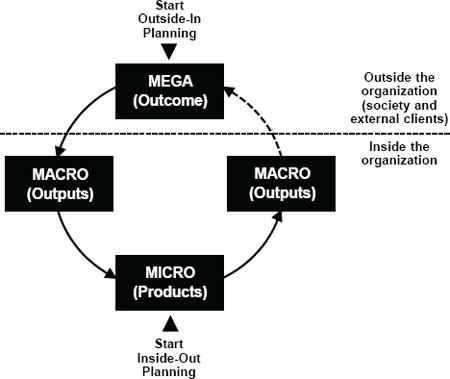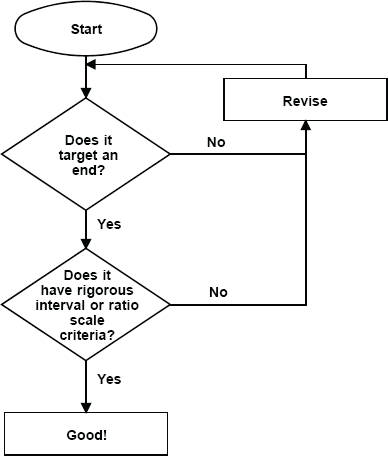Outside-In vs. Inside-Out Planning
Outside-in vs. inside-out planning offers a guide for choosing and delivering societal, community/external client-focused results that you and/or your organization would like to achieve.
Outside-in planning. Beginning with a result (or objective), and track the flow through the Organizational Elements starting from outside/Mega through the other organizational elements, Figure 5.5 Starting from the outside (Mega) and deriving down through the organizational elements will better ensure that the planning will be valid and not assume any linkages.
Inside-out planning. If you are required to be working with others on an existing organizational program or context who want to start from the more “comfortable” and conventional inside-out/upward flow, you must remember if you start inside, make sure that you “roll up” through Macro to Mega and ensure all the external and internal linkages.
Figure 5.5. Inside-out and outside-in planning cycle.7
“Inside-out” is the approach usually done by conventional planners. It is not very often when using this upward flow that people get to precise requirements for Macro or Mega results and consequences, so they miss the assurance that what they use, do, produce, and deliver will add value to all internal and external stakeholders. When starting “inside” their organization or their operational assignments, most people quickly get stuck in their comfort zones and never make the full alignment.8 If you must start inside the organization, double check the completeness of your analysis by checking to see if it is compatible with the out-side-in assessment.
Figure 5.6 shows an algorithm, or job aid, for preparing useful objectives.
Useful Objectives
Figure 5.6. A job aid for preparing useful objectives.
It is basic to Mega Thinking and Planning that everything is results focused; everything is precise, rigorous, and measurable.
Action Steps
1. Be very clear, precise, and rigorous concerning where you are headed and how to measure when you have arrived: measurable objectives and their performance specifications.
2. Act on the basis that everything is measurable—measurable on one of four scales of measurement: Nominal, Ordinal, Interval, and Ratio. Don’t let anyone get away with thinking and acting that there are just some things that are measurable. Show them.
3. Distinguish between ends—results, consequences, performance—and means—the ways to deliver results.
4. Act on the basis that there are three levels of planning (Mega, Macro, and Micro) and three levels of associated results (Outcomes, Outputs, and Products). Don’t blur these—the differences are operationally critical.
5. Prepare objectives for the three levels of planning. Each objective should state where you are headed and how to tell when you have arrived. Figure 5.5 provides guidance. Objectives never include methods, means, activities, approaches, or resources. Never.
6. Be precise. An objective has Interval or Ratio scale indicators. A goal has only Nominal or Ordinal Scale indicators. Use objectives whenever possible.
7. Planning best starts at the level of society (Mega) and then rolls down inside the organization to Macro and Micro levels.
Endnotes
1. Not only should everything be measurable, but all should be based on valid research. Some good guidance is provided by the International Society for Performance Improvement (ISPI) principles that include: Focus on results, take a system approach, add value, partner with others, use needs assessment, conduct performance analysis, design to specifications, systematic selection design and development, implement systematically, and evaluate and do continual improvement (ISPI.org).
2. Stevens, S. S. (1951). Mathematics, measurement, and psychophysics. In Stevens, S. S. Handbook of experimental psychology. New York: John Wiley & Sons.
Kaufman, R. A. (1972). Educational system planning. Engle-wood Cliffs, NJ: Prentice-Hall. (Also Planificacion de systemas educativos [translation of Educational System Planning]. Mexico City: Editorial Trillas, S.A., 1973).
3. Bob Mager set the original standard for measurable objectives. Later, Tom Gilbert made the important distinction between behavior and performance (between actions and consequences). Recently, some “Constructivists” have had objections to writing objectives because they claim it can cut down on creativity and imposes the planner’s values on the clients. This view, I believe, is not useful. For a detailed discussion on the topic of Constructivism, please see the analysis of philosophy professor David Gruender; Gruender, C. D. (May–June, 1996). “Constructivism and learning: A philosophical appraisal. Educational Technology, 36(3), 21–29.
A useful aid is the “Hey Mommy Test.” It encourages you to take whatever purpose statement you have prepared (objective) and state, “Hey Mommy, let me show you how I can…” If it is a useful objective, it will provide a reasonable set of criteria.
4. Based on examples in Moore, S., Ellsworth, J. B., & Kaufman, R. (Aug., 2008). Objectives—are they useful? A quick assessment. Performance Improvement, (47), 7, pp. 41–47.
5. Kaufman, R., Watkins, R., Triner, D., & Stith, M. (1998). The changing corporate mind: Organizations, visions, mission, purposes, and indicators on the move toward societal payoffs. Performance Improvement Quarterly, (11), 3, pp. 32–44.
6. Based on Kaufman, R. (2006). Change, Choices, and Consequences: A Guide to Mega Thinking and Planning. Amherst, MA: HRD Press.
Kaufman, R. (2000). Mega Planning: Practical tools for organizational success. Thousand Oaks, CA: Sage Publications. Also Planificación Mega: Herramientas practices paral el exito organizacional. (2004). Traducción de Sonia Agut. Universitat Jaume I. Castelló de la Plana, Espana.
7. Kaufman, R. (2000). Mega Planning: Practical tools for organizational success. Thousand Oaks, CA: Sage Publications. Also Planificación Mega: Herramientas practices paral el exito organizacional. (2004). Traducción de Sonia Agut. Universitat Jaume I. Castelló de la Plana, Espana.
8. Hinchliffe, D. R. (1995). Training for Results: Determining Education and Training Needs for Emergency Management in Australia. Unpublished doctoral dissertation. Monash University, Clayton Campus, Victoria, Australia.


